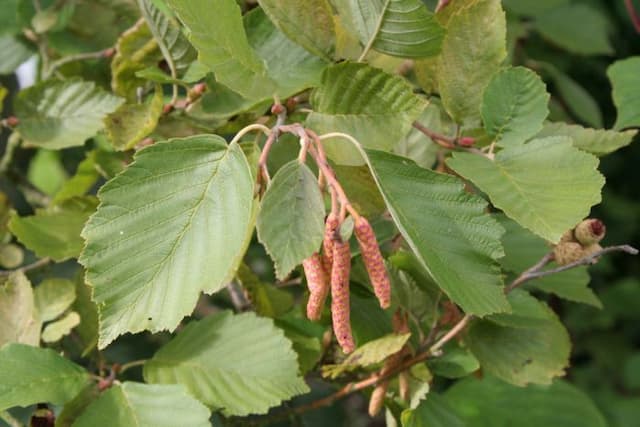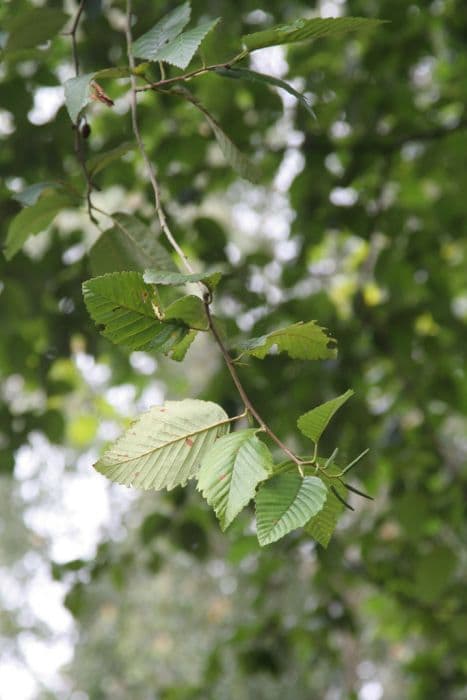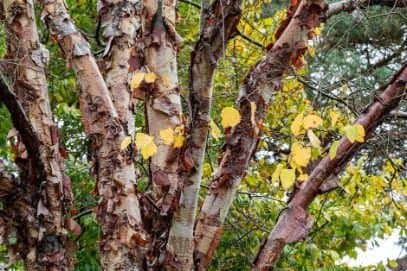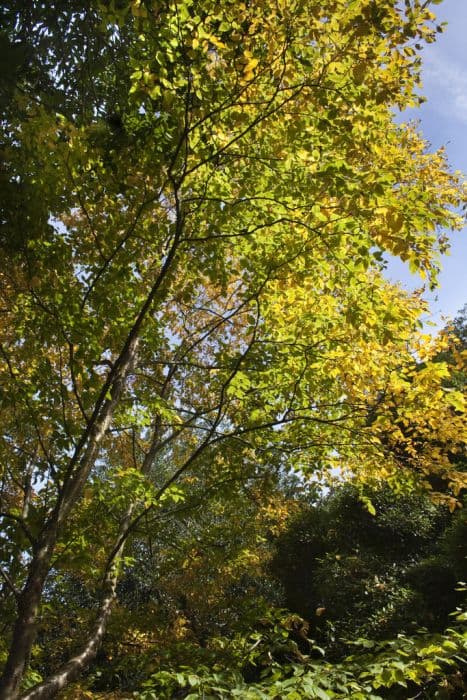Himalayan Birch Betula utilis subsp. utilis 'Forest Blush'

ABOUT
Betula utilis, commonly known as Himalayan birch, is a beautifully ornamental tree prized for its distinct characteristics. 'Forest Blush' is a variety of this birch with a unique appearance that stands out in any landscape. The most striking feature of this tree is its bark. Unlike the typical white bark of the Himalayan birch, 'Forest Blush' has a bark that exhibits a blend of colors. It is primarily creamy-white, but with a gentle pinkish hue that can sometimes be seen, giving it the appearance of a soft blush over the surface. This subtle hint of color adds a warm tone to the tree's exterior. The bark peels off in papery sheets, which is a characteristic trait of the birch family, adding texture and interest to the tree throughout the year. This peeling process reveals new layers of bark underneath, maintaining the tree's vibrant appearance. The leaves of the 'Forest Blush' are a bright green color that turns golden-yellow as the seasons change, before shedding in the fall. This tree produces catkins, which are long, slender clusters of flowers. Some catkins are male, producing pollen, while others are female, eventually developing into clusters of tiny winged seeds that can be carried by the wind. In spring, the appearance of the new leaves and the bright, fresh catkins contrasts beautifully with the light-toned bark, creating a stunning visual display. The 'Forest Blush' cultivar, like its relatives, is known for its graceful, upright, and spreading branches. The branch structure gives the tree an elegant silhouette that can provide interest in gardens and landscapes even in the dormant months without foliage. Overall, Himalayan birch 'Forest Blush' is beloved for its unique bark, attractive foliage, seasonal catkins, and structural beauty, making it a stand-out choice for gardeners and landscapers.
About this plant
 Names
NamesFamily
Betulaceae.
Synonyms
Himalayan Birch, Whitebarked Himalayan Birch, Forest Blush Birch.
Common names
Betula utilis subsp. utilis 'Forest Blush'.
 Toxicity
ToxicityTo humans
Himalayan Birch is generally not considered toxic to humans. Therefore, ingestion of this plant typically does not result in poisoning or adverse symptoms.
To pets
Himalayan Birch is also generally regarded as non-toxic to pets. Ingesting parts of this plant should not cause any significant symptoms of poisoning or toxic reactions in animals. However, it is always advisable to monitor pets and prevent them from eating large amounts of any non-food plants, as it may cause gastrointestinal discomfort or blockages.
 Characteristics
CharacteristicsLife cycle
Perennials
Foliage type
Deciduous
Color of leaves
Varies
Flower color
Varies
Height
40 feet (12 meters)
Spread
20 feet (6 meters)
Plant type
Tree
Hardiness zones
7
Native area
Himalayas
Benefits
 General Benefits
General Benefits- Aesthetic Appeal: The 'Forest Blush' variety of the Himalayan Birch stands out with its striking white bark tinged with pink, offering a unique aesthetic that can enhance a range of landscape designs.
- Seasonal Interest: This cultivar provides year-round interest with its peeling bark, catkins in the spring, and yellow foliage in the fall.
- Erosion Control: The root system helps stabilize the soil, making it a good choice for controlling erosion on slopes or riverbanks.
- Wildlife Habitat: It offers habitat and food for various wildlife species, including birds that feed on the seeds and insects that find a home in its bark.
- Tolerance to Cold: Himalayan Birch is well-adapted to cold climates, capable of surviving and thriving in chilly and frost-prone regions.
- Low Maintenance: Once established, it requires minimal care, making it a practical choice for gardeners seeking a low-maintenance tree.
- Shade Provision: Its canopy can provide a pleasant shade in gardens, parks, and other landscapes, which is particularly appreciated during the warmer months.
- Urban Tolerant: The Himalayan Birch is relatively tolerant of urban pollution and can be planted in city environments with relative success.
- Soil Adaptability: It is adaptable to a variety of soil conditions, although it prefers moist, well-drained soils, it can still grow in less than ideal soil types.
 Medical Properties
Medical Properties- Antiseptic: The bark of Betula utilis, commonly known as Himalayan birch, has been used for its antiseptic properties.
- Anti-inflammatory: Himalayan birch bark extract may have anti-inflammatory effects.
- Wound healing: Traditionally used to promote wound healing due to the presence of betulinic acid in the bark.
 Air-purifying Qualities
Air-purifying QualitiesThis plant is not specifically known for air purifying qualities.
 Other Uses
Other Uses- Paper Production: Betula utilis, commonly known as Himalayan Birch, has a white bark that can be used in the manufacture of high-quality paper for artworks, especially for its texture and durability.
- Furniture Making: The wood of Himalayan Birch is hard and sturdy, making it suitable for crafting furniture such as tables, chairs, and cabinets.
- Leather Industry: The bark extract of Himalayan Birch contains tannins that can be utilized in the leather tanning process to produce durable and high-quality leather goods.
- Dyeing Material: The bark of the Himalayan Birch contains pigments that can be used in the natural dyeing of fabrics, yielding colors from warm browns to pale yellows.
- Landscape Gardening: Himalayan Birch trees, with their distinctive bark and graceful appearance, can be used as ornamental elements in landscape design and garden aesthetics.
- Folk Art Materials: Pieces of Himalayan Birch bark can be used as a canvas for folk art and traditional paintings, preserving cultural art forms.
- Environmental Monitoring: As a bioindicator, Himalayan Birch can be used to monitor environmental conditions, such as soil acidity and air quality, without directly measuring air purifying properties.
- Craft Materials: Strips of the bark can be crafted into rustic decorative items, such as baskets, mats, and wall hangings.
- Waterproofing Material: Due to its water-resistant properties, the bark of the Himalayan Birch can be used in traditional boat building and roofing.
- Culinary Wrapping: In some cultures, the bark may be used as a wrapping material for cooking certain dishes, imparting a subtle flavor and preventing the dish from sticking to cookware.
Interesting Facts
 Feng Shui
Feng ShuiThe Himalayan Birch is not used in Feng Shui practice.
 Zodiac Sign Compitability
Zodiac Sign CompitabilityThe Himalayan Birch is not used in astrology practice.
 Plant Symbolism
Plant Symbolism- Purity: The bark of the Himalayan Birch (Betula utilis 'Forest Blush'), with its distinctive white color, often symbolizes purity and the cleansing of one's spirit.
- New Beginnings: As a tree that can pioneer new growth in disturbed soil, the Himalayan Birch represents new beginnings and the start of a fresh journey.
- Adaptation: Given its ability to thrive in various conditions, this plant symbolizes adaptability and the capacity to flourish in changing environments.
- Protection: In some cultures, birch trees are believed to ward off evil, signifying protection and safety.
- Renaissance: The tree’s vigorous growth after being cut back or damaged makes it a symbol of resilience and renaissance after hardship.
 Water
WaterHimalayan Birch should be watered deeply once or twice a week, depending on the soil moisture level and weather conditions. Newly planted trees will benefit from about 10 to 15 gallons of water each time to ensure proper establishment. Once established, decrease the frequency to every two to three weeks, providing 15 to 20 gallons to maintain a healthy moisture level. During hot and dry periods, increase the frequency of watering but avoid overwatering to prevent root rot. Adjustments should be made for rainfall and temperature changes to ensure the soil remains consistently moist but not waterlogged.
 Light
LightThe Himalayan Birch thrives in full sun to partial shade. It should be positioned in a location where it can receive at least six hours of direct sunlight daily. Avoid areas that are heavily shaded as this can limit the tree's growth and overall health. The ideal spot for this tree is in a bright space where the sunlight is plentiful but has some protection from intense afternoon sun in hotter climates.
 Temperature
TemperatureThe Himalayan Birch is cold hardy and can withstand temperatures down to around -40 degrees Fahrenheit, making it suitable for many temperate climates. It can also tolerate heat up to 80 degrees Fahrenheit, but the ideal temperature range for this tree is between 30 to 75 degrees Fahrenheit. To ensure the tree's health, avoid prolonged exposure to extreme temperatures, either hot or cold.
 Pruning
PruningPrune the Himalayan Birch to remove dead, damaged, or diseased branches, improve its shape, and allow for better airflow through the canopy. The best time to prune is during the late winter or early spring before new growth starts. Pruning once a year or once every two years is often adequate. Make clean cuts with sharp pruning tools to minimize stress and reduce the risk of infection.
 Cleaning
CleaningNot needed
 Soil
SoilThe Himalayan Birch 'Forest Blush' thrives in well-draining, loamy soil enriched with organic matter. A mix of equal parts garden soil, compost, and perlite or sand can facilitate good drainage and aeration. Aim for a soil pH of slightly acidic to neutral, around 5.5 to 7.0.
 Repotting
RepottingHimalayan Birch 'Forest Blush' trees, being larger landscape plants, do not require frequent repotting. As young trees, they may need repotting every 2-3 years, but as they mature, repotting should be done only when necessary, such as when they outgrow their space or when soil quality degrades.
 Humidity & Misting
Humidity & MistingHimalayan Birch 'Forest Blush' prefers moderate humidity levels and can tolerate the variable outdoor humidity but is not suited for extremely dry indoor environments.
 Suitable locations
Suitable locationsIndoor
Not ideal indoors; needs ample space, light.
Outdoor
Plant in full sun to partial shade, space well.
Hardiness zone
5-7 USDA
 Life cycle
Life cycleThe most common name for Betula utilis subsp. utilis 'Forest Blush' is Himalayan Birch. The life cycle of the Himalayan Birch starts with germination, where the seed, often dispersed by wind due to its lightweight nature, finds suitable soil and begins to sprout. Following germination, the seedling undergoes rapid growth, developing a sturdy root system and a straight, slender trunk with characteristic peeling white bark. As the tree matures into the juvenile stage, it begins to form branches and leaves, engaging in photosynthesis and further growth in height and girth. The adult Himalayan Birch then reaches the reproductive stage, producing catkins that contain male and female flowers, which after pollination, develop into seeds to be dispersed. Finally, as the tree ages and reaches the senescence stage, growth slows, and it becomes more susceptible to environmental stresses, eventually leading to its death and return of nutrients to the ecosystem through decomposition.
 Propogation
PropogationPropogation time
Late Winter to Early Spring
For Betula utilis, commonly known as Himalayan birch, the most popular method of propagation is by seed. Seeds are typically sown in the fall after collection, as they require a period of cold stratification to break dormancy. This period simulates the natural winter conditions the seeds would experience in their native habitat. After stratification, which can last for about 90 days, the seeds are sown in well-drained seedbeds or containers filled with a mixture of sand and peat, kept moist but not waterlogged. Germination often occurs in the spring when temperatures rise. Seedlings are then grown on for one to two years before being planted out in their final location. Care must be taken during the initial growth period to ensure that the delicate seedlings are protected from extreme weather conditions and provided with adequate water and nutrients.









